Fractal Feature Analysis and Information Extraction of Woodlands Based on MODIS NDVI Time Series
Abstract
:1. Introduction
2. Materials and Methods
2.1. Study Area
2.2. Data and Data Processing
2.3. Methods
2.3.1. Blanket Method
2.3.2. Accuracy Assessment
3. Results
3.1. Fractal Features and Analysis
- (1)
- The upper and lower fractal profiles and signal images were different. The upper fractal signals of different targets were mainly concentrated at measure units ε 6 to 14 and the lower fractal signals were mainly located at ε 2 to 8.
- (2)
- Both the upper and lower fractal signal values of different targets were different at the same measure unit, and the fractal signal value of the same object had a clear distinction at the different measure units.
- (3)
- Four typical targets, woodland, cropland, grassland, and water body, could be clearly identified at the upper fractal profiles and signal images. Woodland and grassland were also different from other classes at lower fractal profiles and signal images. The fractal profiles and signal images of built-up land had no obvious variation at the upper and lower fractal. The fractal results were decided by the shape or complexity of the NDVI time series curves for the given target.
- (4)
- Woodland was reflected at upper fractal profiles of ε = 8 and lower fractal profiles of ε = 5. The size of the fractal signal value and its difference from other targets were taken into account to choose the fifth scale of the lower fractal as the defining fractal feature scale of woodland. Figure 5 is the lower fractal signal image of ε = 5. The image is expressed with color to increase the visual contrast and separability, and woodland is displayed in red in the image.
- (5)
- The results show that fractals can reveal clear separations of different targets at different scales, and a higher precision of information extraction or classification may be expected based on fractal features.
3.2. Information Extraction and Accuracy Assessment
3.3. Comparative Analysis of the Extracted Results and Accuracy Assessment
3.3.1. Comparison with Related Studies
3.3.2. Fractal-Based and NDVI-Based Comparative Experiments
4. Discussion
4.1. Theoretical Assumptions
4.2. Applicability of Fractal Method and Significance of Fractal Parameters
4.3. Support for Government Projects Using the Information Extraction Method for Woodlands
5. Conclusions
Acknowledgments
Author Contributions
Conflicts of Interest
References
- Sterling, S.M.; Ducharne, A.; Polcher, J. The impact of global land-cover change on the terrestrial water cycle. Nat. Clim. Chang. 2013, 3, 385–390. [Google Scholar] [CrossRef]
- Pitman, A.; Avila, F.; Abramowitz, G.; Wang, Y.; Phipps, S.; de Noblet-Ducoudré, N. Importance of background climate in determining impact of land-cover change on regional climate. Nat. Clim. Chang. 2011, 1, 472–475. [Google Scholar] [CrossRef]
- Pielke, R.A. Land use and climate change. Science 2005, 310, 1625–1626. [Google Scholar] [CrossRef] [PubMed]
- Mooney, H.A.; Duraiappah, A.; Larigauderie, A. Evolution of natural and social science interactions in global change research programs. Proc. Natl. Acad. Sci. USA 2013, 110, 3665–3672. [Google Scholar] [CrossRef] [PubMed]
- Chen, X.; Zhao, H.; Li, P.; Yin, Z. Remote sensing image-based analysis of the relationship between urban heat island and land use/cover changes. Remote Sens. Environ. 2006, 104, 133–146. [Google Scholar] [CrossRef]
- Gimona, A.; Poggio, L.; Brown, I.; Castellazzi, M. Woodland networks in a changing climate: Threats from land use change. Biol. Conserv. 2012, 149, 93–102. [Google Scholar] [CrossRef]
- Feng, Z.; Yang, Y.; Zhang, Y.; Zhang, P.; Li, Y. Grain-for-green policy and its impacts on grain supply in west China. Land Use Policy 2005, 22, 301–312. [Google Scholar] [CrossRef]
- Shan, N.; Shi, Z.; Yang, X.; Gao, J.; Cai, D. Spatiotemporal trends of reference evapotranspiration and its driving factors in the Beijing–Tianjin sand source control project region, China. Agric. For. Meteorol. 2015, 200, 322–333. [Google Scholar] [CrossRef]
- Wu, Z.; Wu, J.; Liu, J.; He, B.; Lei, T.; Wang, Q. Increasing terrestrial vegetation activity of ecological restoration program in the Beijing–Tianjin sand source region of China. Ecol. Eng. 2013, 52, 37–50. [Google Scholar] [CrossRef]
- Cao, S.; Li, Y.; Lu, C. A measure of the net value of ecosystem services and the evaluation of Beijing plain afforestation project. Chin. Sci. Bull. 2016, 61, 2724–2729. [Google Scholar]
- Liu, J.; Li, S.; Ouyang, Z.; Tam, C.; Chen, X. Ecological and socioeconomic effects of China’s policies for ecosystem services. Proc. Natl. Acad. Sci. USA 2008, 105, 9477–9482. [Google Scholar] [CrossRef] [PubMed]
- Peng, S.; Piao, S.; Zeng, Z.; Ciais, P.; Zhou, L.; Li, L.; Myneni, R.; Yin, Y.; Zeng, H. Afforestation in China cools local land surface temperature. Proc. Natl. Acad. Sci. USA 2014, 111, 2915–2919. [Google Scholar] [CrossRef] [PubMed]
- Ouyang, Z.; Zheng, H.; Xiao, Y.; Polasky, S.; Liu, J.; Xu, W.; Wang, Q.; Zhang, L.; Xiao, Y.; Rao, E.; et al. Improvements in ecosystem services from investments in natural capital. Science 2016, 352, 1455–1459. [Google Scholar] [CrossRef] [PubMed]
- Yang, J.; Weisberg, P.; Bristow, N. Landsat remote sensing approaches for monitoring long-term tree cover dynamics in semi-arid woodlands: Comparison of vegetation indices and spectral mixture analysis. Remote Sens. Environ. 2012, 119, 62–71. [Google Scholar] [CrossRef]
- Hou, Z.; Xu, Q.; Nuutinen, T.; Tokola, T. Extraction of remote sensing-based forest management units in tropical forests. Remote Sens. Environ. 2013, 130, 1–10. [Google Scholar] [CrossRef]
- Garrity, S.R.; Allen, C.D.; Brumby, S.P.; Gangodagamage, C.; McDowell, N.G.; Cai, D.M. Quantifying tree mortality in a mixed species woodland using multitemporal high spatial resolution satellite imagery. Remote Sens. Environ. 2013, 129, 54–65. [Google Scholar] [CrossRef]
- Xia, J.; Du, P.; He, X.; Chanussot, J. Hyperspectral remote sensing image classification based on rotation forest. IEEE Geosci. Remote Sens. Lett. 2014, 11, 239–243. [Google Scholar] [CrossRef]
- Engler, R.; Waser, L.T.; Zimmermann, N.E.; Schaub, M.; Berdos, S.; Ginzler, C.; Psomas, A. Combining ensemble modeling and remote sensing for mapping individual tree species at high spatial resolution. For. Ecol. Manag. 2013, 310, 64–73. [Google Scholar] [CrossRef]
- Du, L.; Zhou, T.; Zou, Z.; Zhao, X.; Huang, K.; Wu, H. Mapping forest biomass using remote sensing and national forest inventory in China. Forests 2014, 5, 1267–1283. [Google Scholar] [CrossRef]
- Pouliot, D.; Latifovic, R.; Fernandes, R.; Olthof, I. Evaluation of annual forest disturbance monitoring using a static decision tree approach and 250 m MODIS data. Remote Sens. Environ. 2009, 113, 1749–1759. [Google Scholar] [CrossRef]
- Stellmes, M.; Röder, A.; Udelhoven, T.; Hill, J. Mapping syndromes of land change in Spain with remote sensing time series, demographic and climatic data. Land Use Policy 2013, 30, 685–702. [Google Scholar] [CrossRef]
- Liu, J.; Kuang, W.; Zhang, Z.; Xu, X.; Qin, Y.; Ning, J.; Zhou, W.; Zhang, S.; Li, R.; Yan, C.; et al. Spatiotemporal characteristics, patterns, and causes of land-use changes in China since the late 1980s. J. Geogr. Sci. 2014, 24, 195–210. [Google Scholar] [CrossRef]
- Xu, L.; Li, B.; Yuan, Y.; Gao, X.; Zhang, T.; Sun, Q. Detecting different types of directional land cover changes using MODIS NDVI time series dataset. Remote Sens. 2016, 8, 495. [Google Scholar] [CrossRef]
- Kurnar, D. Monitoring forest cover changes using remote sensing and GIS: A global prospective. Res. J. Environ. Sci. 2011, 5, 105–123. [Google Scholar]
- Chen, J.; Chen, J.; Liao, A.; Cao, X.; Chen, L.; Chen, X.; He, C.; Han, G.; Peng, S.; Lu, M.; et al. Global land cover mapping at 30 m resolution: A pok-based operational approach. ISPRS J. Photogramm. Remote Sens. 2015, 103, 7–27. [Google Scholar] [CrossRef]
- Peleg, S.; Naor, J.; Hartley, R.; Avnir, D. Multiple resolution texture analysis and classification. IEEE Trans. Pattern Anal. Mach. Intell. 1984, 6, 518–523. [Google Scholar] [CrossRef] [PubMed]
- Jolliffe, I. Principal Component Analysis; Wiley Online Library: New York, NY, USA, 2002. [Google Scholar]
- Torrence, C.; Compo, G.P. A practical guide to wavelet analysis. Bull. Am. Meteorol. Soc. 1998, 79, 61–78. [Google Scholar] [CrossRef]
- Mandelbrot, B.B.; Aizenman, M. Fractals: Form, chance, and dimension. Phys. Today 1979, 32, 65. [Google Scholar] [CrossRef]
- Xia, Y.; Feng, D.; Zhao, R. Morphology-based multifractal estimation for texture segmentation. IEEE Trans. Image Process. 2006, 15, 614–623. [Google Scholar] [PubMed]
- Guo, Q.; Shao, J.; Guo, F.; Ruiz, V. Classification of mammographic masses using geometric symmetry and fractal analysis. Int. J. Comput. Assist. Radiol. Surg. 2007, 2, 336–338. [Google Scholar]
- Bishop, M.P.; Shroder, J.F., Jr.; Hickman, B.L.; Copland, L. Scale-dependent analysis of satellite imagery for characterization of glacier surfaces in the Karakoram Himalaya. Geomorphology 1998, 21, 217–232. [Google Scholar] [CrossRef]
- Parrinello, T.; Vaughan, R. Multifractal analysis and feature extraction in satellite imagery. Int. J. Remote Sens. 2002, 23, 1799–1825. [Google Scholar] [CrossRef]
- Weng, Q. Fractal analysis of satellite-detected urban heat island effect. Photogramm. Eng. Remote Sens. 2003, 69, 555–566. [Google Scholar] [CrossRef]
- Myint, S. Fractal approaches in texture analysis and classification of remotely sensed data: Comparisons with spatial autocorrelation techniques and simple descriptive statistics. Int. J. Remote Sens. 2003, 24, 1925–1947. [Google Scholar] [CrossRef]
- Chaudhuri, B.B.; Sarkar, N. Texture segmentation using fractal dimension. IEEE Trans. Pattern Anal. Mach. Intell. 1995, 17, 72–77. [Google Scholar] [CrossRef]
- Sun, W.; Xu, G.; Gong, P.; Liang, S. Fractal analysis of remotely sensed images: A review of methods and applications. Int. J. Remote Sens. 2006, 27, 4963–4990. [Google Scholar] [CrossRef]
- Beijing Municipal Bureau of Statistics; NBS Survey Office in Beijing. Beijing Statistical Yearbook 2016; China Statistics Press: Beijing, China, 2016. [Google Scholar]
- Wang, X.; Niu, S.; Kan, Z. Properties and flammability of major tree species in the Beijing area. Front. For. China 2009, 4, 304–308. [Google Scholar] [CrossRef]
- Didan, K. MOD13Q1 MODIS/Terra Vegetation Indices 16-Day L3 Global 250 m SIN Grid V006; NASA EOSDIS Land Processes DAAC; NASA: College Park, MD, USA, 2015.
- Huete, A.; Didan, K.; Miura, T.; Rodriguez, E.; Gao, X.; Ferreira, L. Overview of the radiometric and biophysical performance of the MODIS vegetation indices. Remote Sens. Environ. 2002, 83, 195–213. [Google Scholar] [CrossRef]
- Chen, J.; Jönsson, P.; Tamura, M.; Gu, Z.; Matsushita, B.; Eklundh, L. A simple method for reconstructing a high-quality NDVI time-series data set based on the Savitzky–Golay filter. Remote Sens. Environ. 2004, 91, 332–344. [Google Scholar] [CrossRef]
- Gorry, P. General least-squares smoothing and differentiation by the convolution (Savitzky-Golay) method. Anal. Chem. 1990, 62, 570–573. [Google Scholar] [CrossRef]
- Liu, J.; Liu, M.; Tian, H.; Zhuang, D.; Zhang, Z.; Zhang, W.; Tang, X.; Deng, X. Spatial and temporal patterns of China’s cropland during 1990–2000: An analysis based on Landsat TM data. Remote Sens. Environ. 2005, 98, 442–456. [Google Scholar] [CrossRef]
- Liu, J.; Liu, M.; Deng, X.; Zhuang, D.; Zhang, Z.; Luo, D. The land use and land cover change database and its relative studies in China. J. Geogr. Sci. 2002, 12, 275–282. [Google Scholar]
- Dong, P. Fractal signatures for multiscale processing of hyperspectral image data. Adv. Space Res. 2008, 41, 1733–1743. [Google Scholar] [CrossRef]
- Liu, C.R.; Frazier, P.; Kumar, L. Comparative assessment of the measures of thematic classification accuracy. Remote Sens. Environ. 2007, 107, 606–616. [Google Scholar] [CrossRef]
- Chen, J.; Ban, Y.; Li, S. Open access to earth land-cover map. Nature 2014, 514, 434. [Google Scholar] [CrossRef]
- Arino, O.; Bicheron, P.; Achard, F.; Latham, J.; Witt, R.; Weber, J.L. GlobCover the most detailed portrait of earth. ESA Bull. Eur. Space Agency 2008, 136, 24–31. [Google Scholar]
- Friedl, M.A.; Sulla-Menashe, D.; Tan, B.; Schneider, A.; Ramankutty, N.; Sibley, A.; Huang, X.M. MODIS collection 5 global land cover: Algorithm refinements and characterization of new datasets. Remote Sens. Environ. 2010, 114, 168–182. [Google Scholar] [CrossRef]
- Pentland, A.P. Fractal-based description of natural scenes. IEEE Trans. Pattern Anal. Mach. Intell. 1984, 6, 661–674. [Google Scholar] [CrossRef] [PubMed]
- Luan, H.; Tian, Q.; Yu, T.; Hu, X.; Huang, Y.; Du, L.; Zhao, L.; Wei, X.; Han, J.; Zhang, Z.; et al. Modeling continuous scaling of NDVI based on fractal theory. Spectrosc. Spectr. Anal. 2013, 33, 1857–1862. [Google Scholar]
- Riccio, D.; Ruello, G. Synthesis of fractal surfaces for remote-sensing applications. IEEE Trans. Geosci. Remote Sens. 2015, 53, 3803–3814. [Google Scholar] [CrossRef]
- Guan, J.; Liu, N.; Huang, Y.; He, Y. Fractal poisson model for target detection within spiky sea clutter. IEEE Geosci. Remote Sens. Lett. 2013, 10, 411–415. [Google Scholar] [CrossRef]
- Dymond, C.; Mladenoff, D.; Radeloff, V. Phenological differences in Tasseled Cap indices improve deciduous forest classification. Remote Sens. Environ. 2002, 80, 460–472. [Google Scholar] [CrossRef]
- Zhong, L.; Hawkins, T.; Biging, G.; Gong, P. A phenology-based approach to map crop types in the San Joaquin Valley, California. Int. J. Remote Sens. 2011, 32, 7777–7804. [Google Scholar] [CrossRef]
- Wohlfart, C.; Liu, G.; Huang, C.; Kuenzer, C. A river basin over the course of time: Multi-temporal analyses of land surface dynamics in the Yellow River Basin (China) based on medium resolution remote sensing data. Remote Sens. 2016, 8, 186. [Google Scholar] [CrossRef]
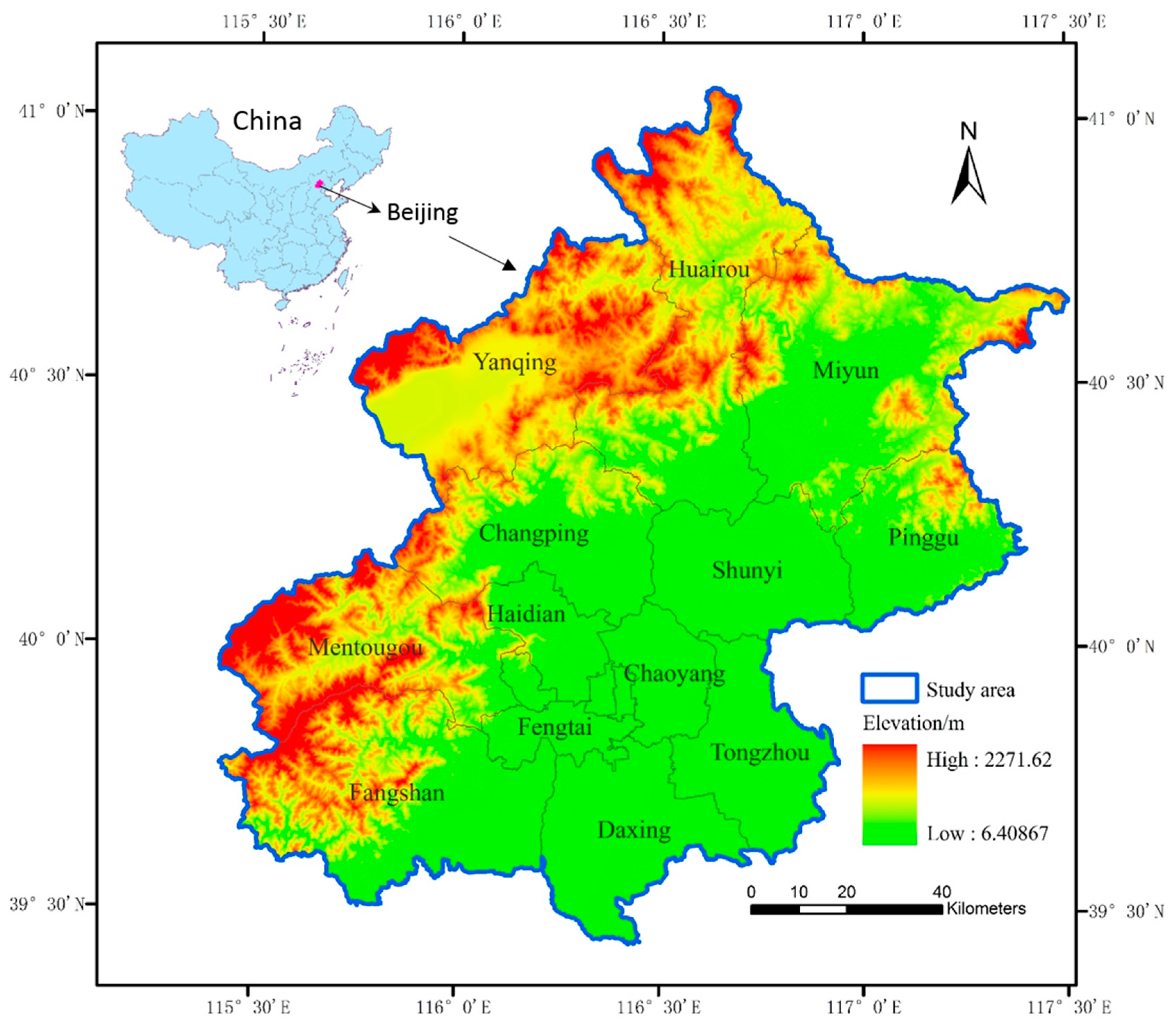
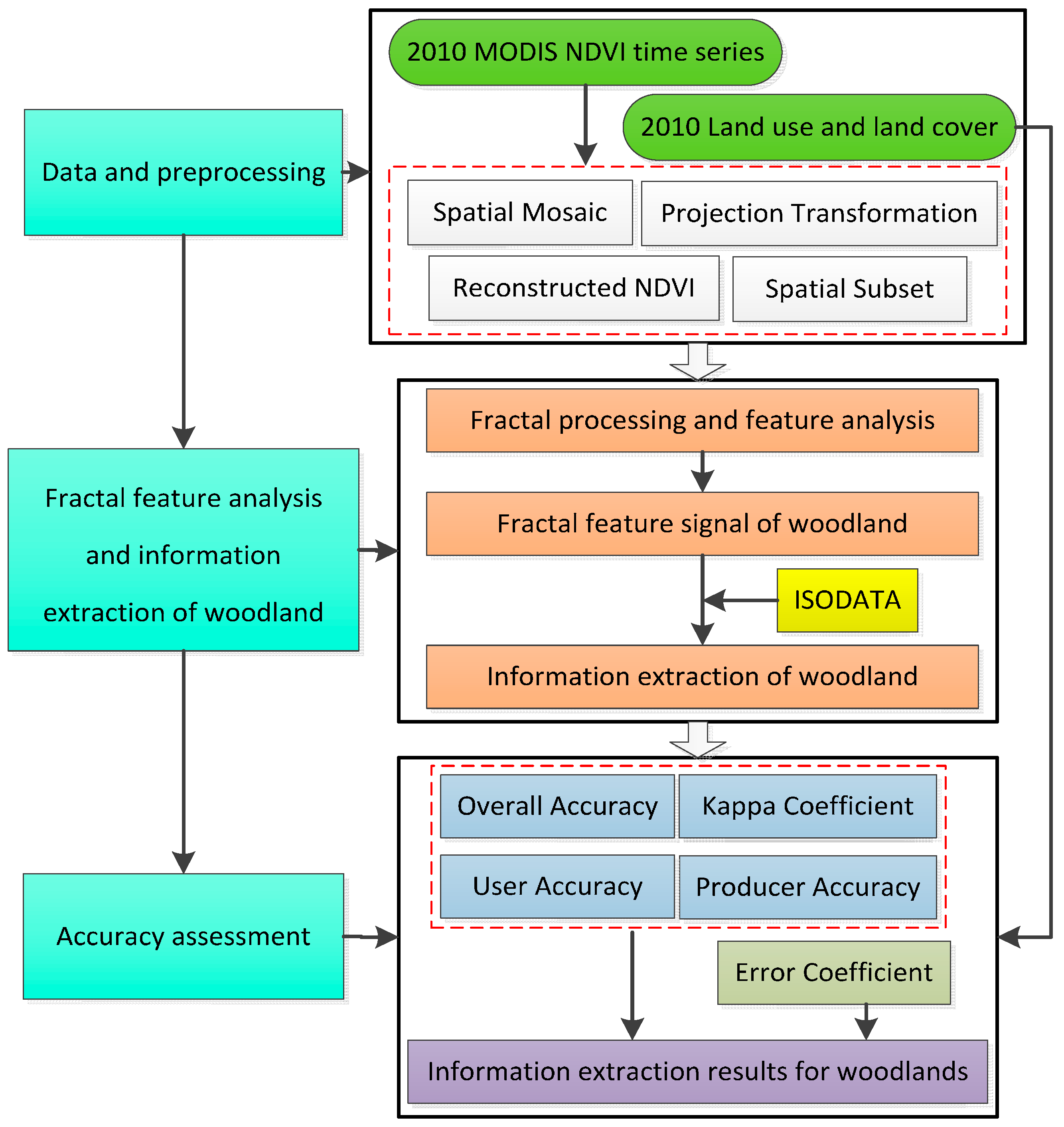

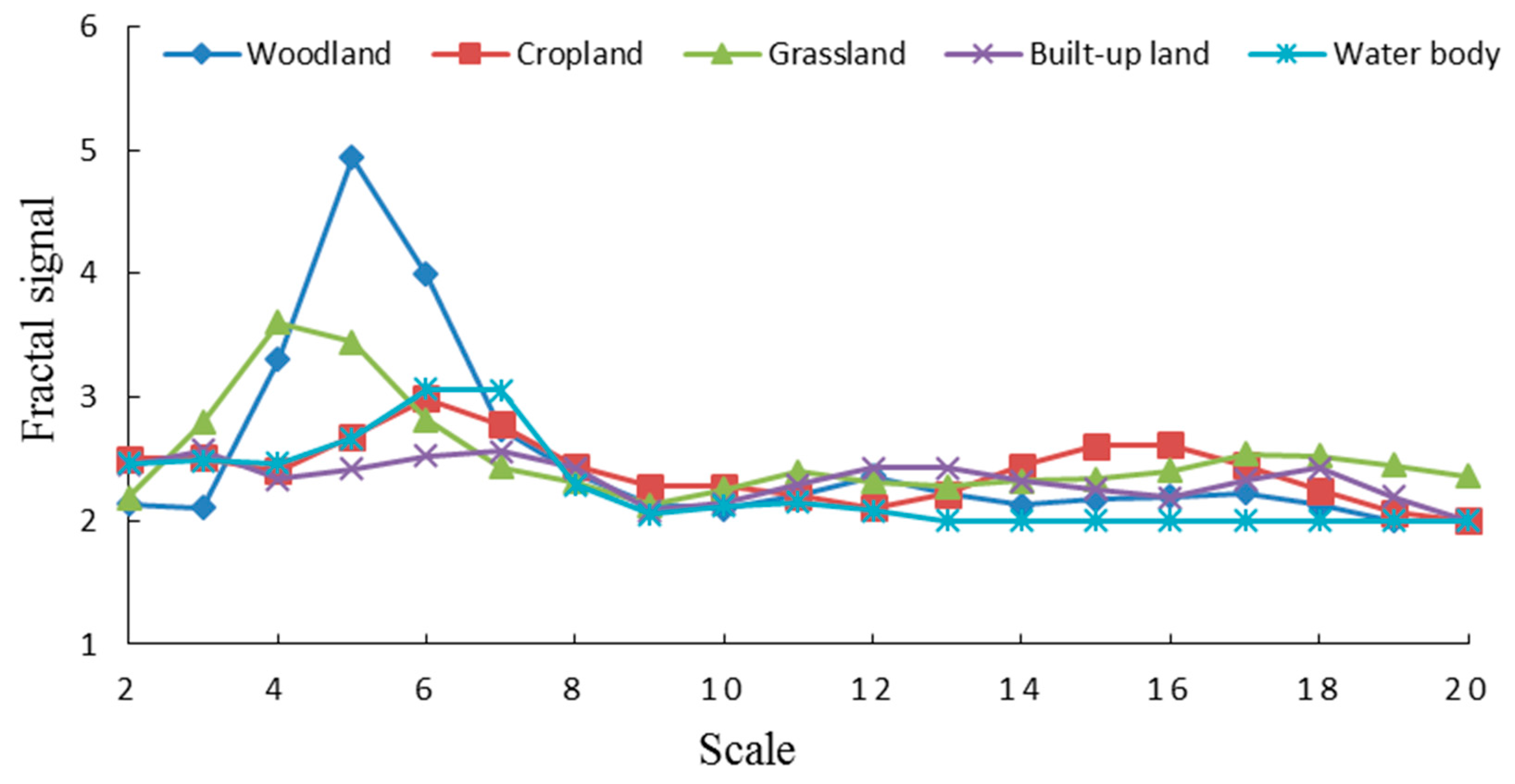

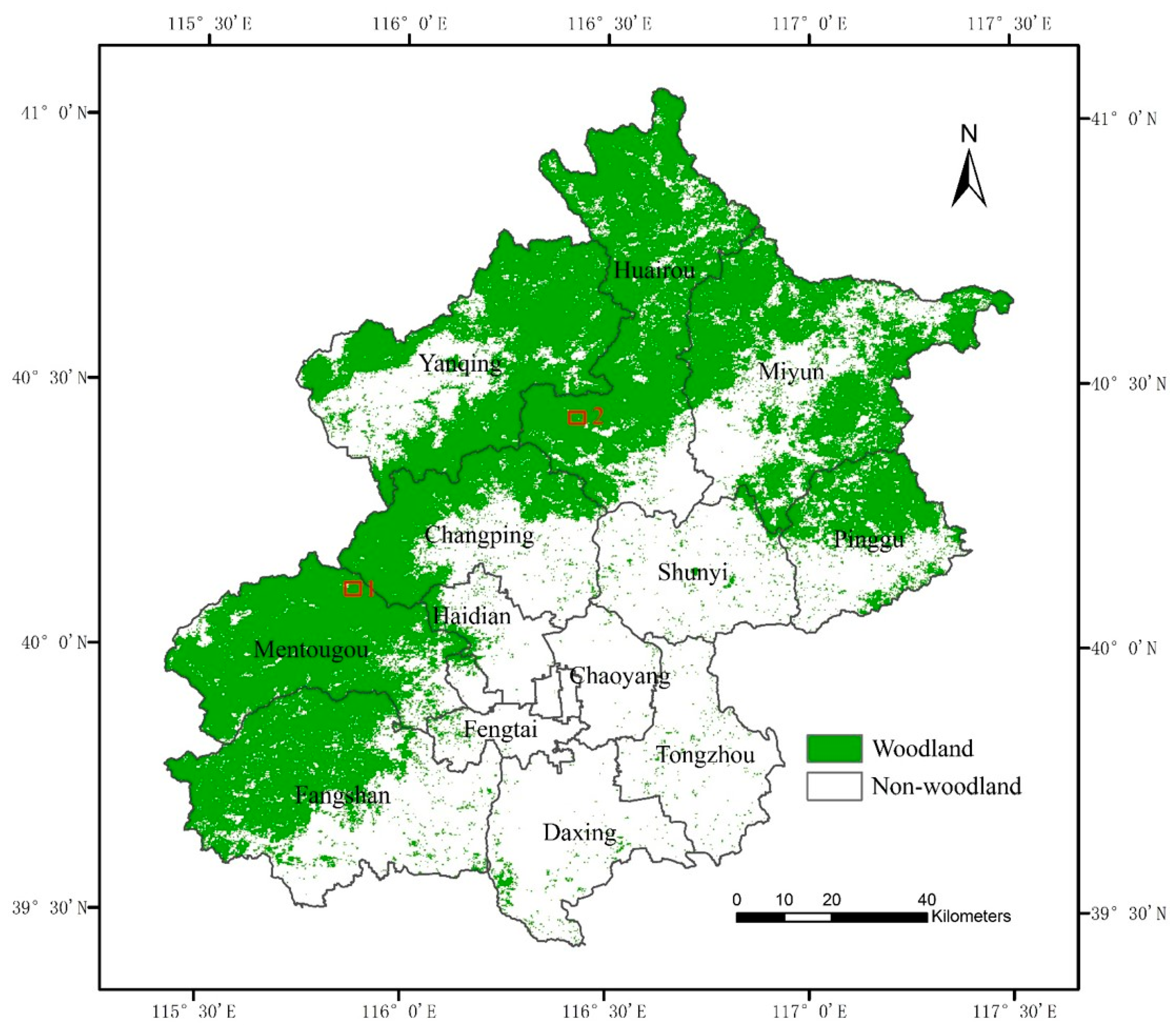

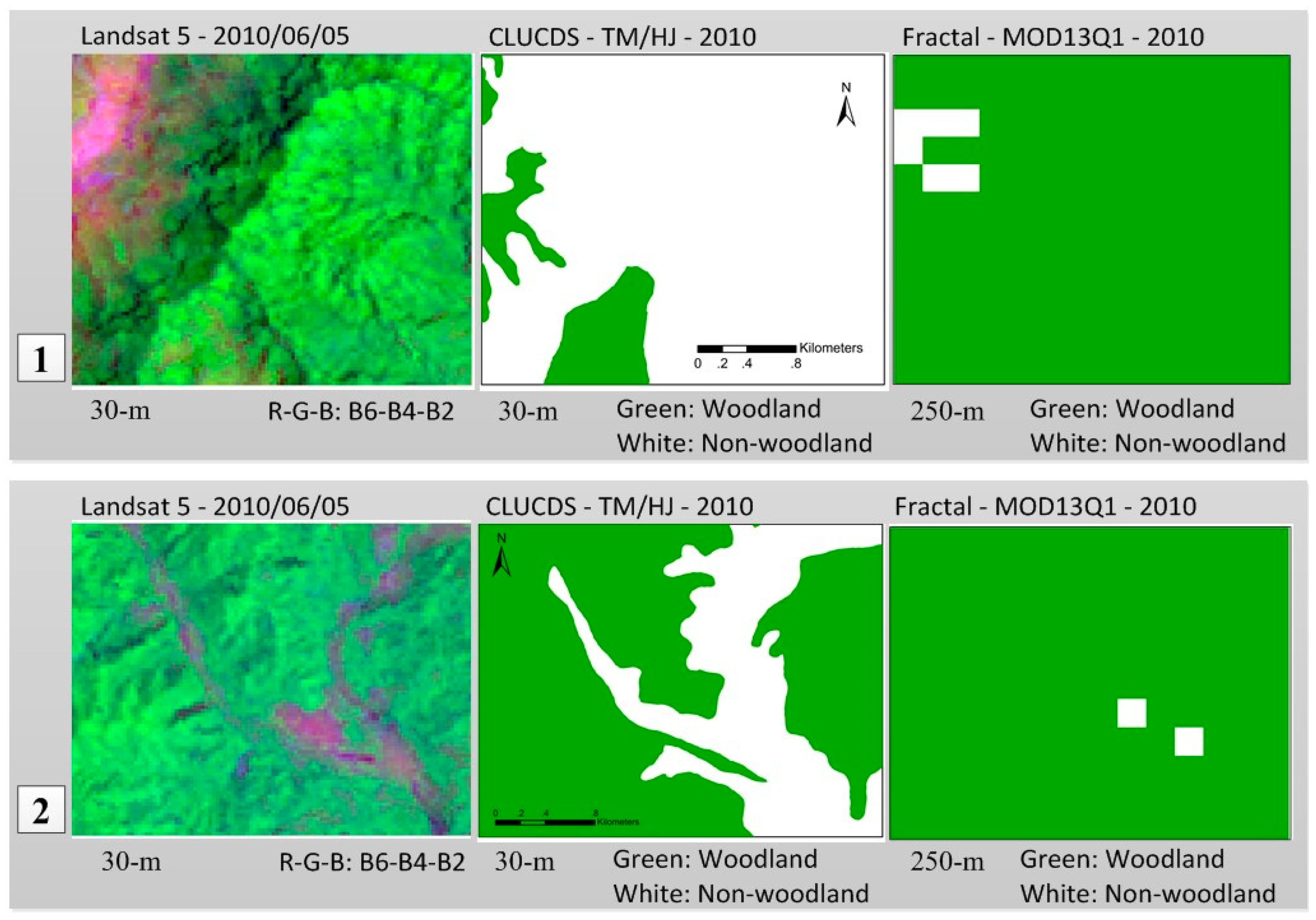

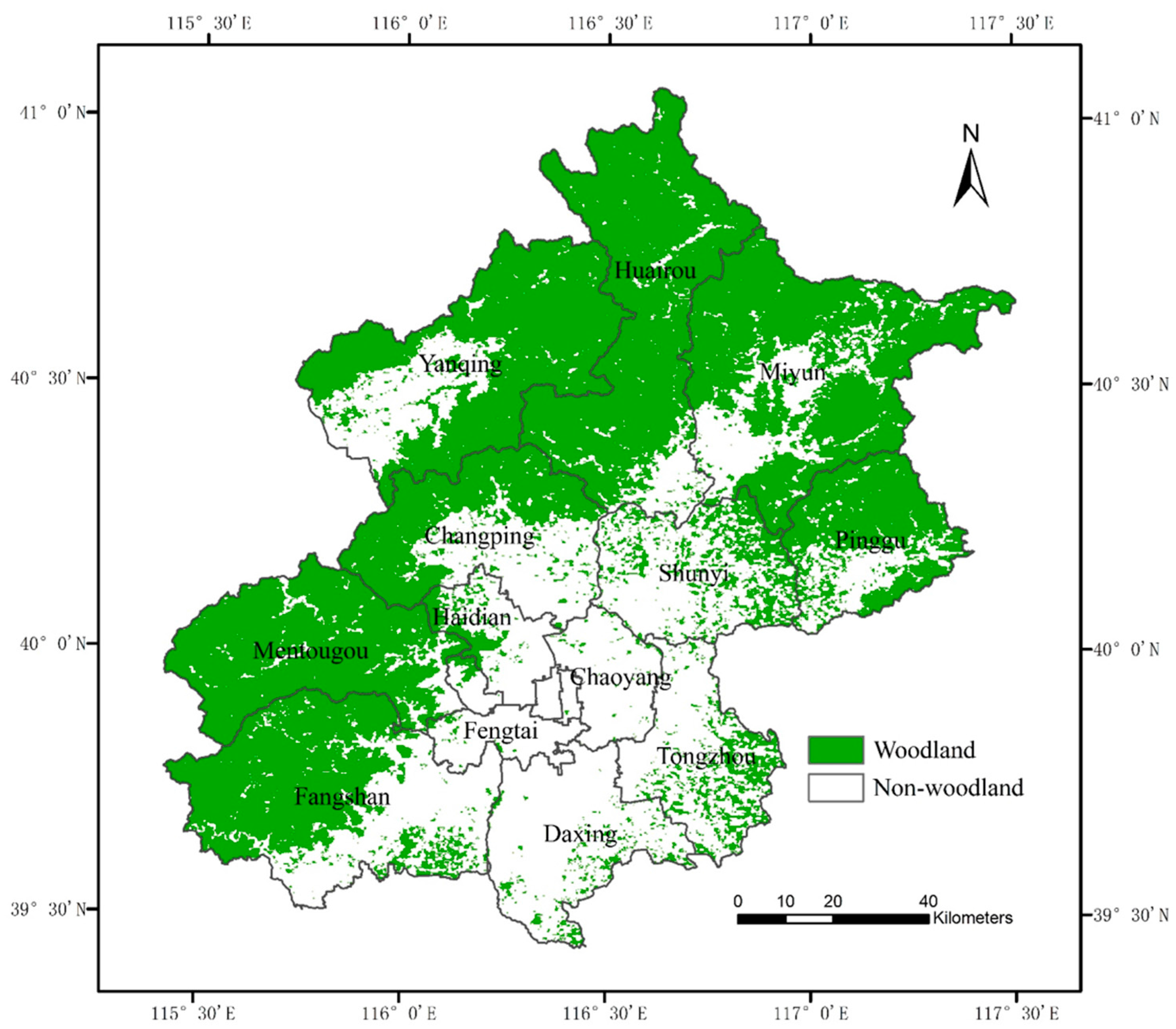
| Indices | PA, % | UA, % | OA, % | Kappa | Error, % |
|---|---|---|---|---|---|
| Woodlands | 83.54 | 77.21 | 90.54 | 0.74 | 8.17 |
| Datasets | Data Sources | SR | Year | Woodland Area, km2 | Error, % | |
|---|---|---|---|---|---|---|
| Fractal-Based | NDVI-Based | |||||
| MOD13Q1 | MODIS/TERRA | 250 m | 2010 | 7984.712, 9682.340 | / | / |
| CLUCDS | Landsat/TM, HJ/CCD | 30 m | 2010 | 7381.399 | 8.17 | 31.17 |
| GlobeLand30 | Landsat/TM, HJ/CCD | 30 m | 2010 | 7329.068 | 8.95 | 32.11 |
| GlobCover | ENVISAT/MERIS | 300 m | 2009 | 7385.670 | 8.11 | 31.10 |
| MCD12Q1-IGBP | MODIS/TERRA | 500 m | 2010 | 7523.750 | 6.13 | 28.69 |
| MCD12Q1-UMD | MODIS/TERRA | 500 m | 2010 | 7583.750 | 5.29 | 27.67 |
| Beijing Statistical Yearbook (BSY) | Survey Statistics | / | 2010 | 7420.185 | 7.61 | 30.49 |
| Woodlands | Area, km2 | PA, % | UA, % | OA, % | Kappa | Error, % |
|---|---|---|---|---|---|---|
| Fractal-based | 7984.712 | 83.54 | 77.21 | 90.54 | 0.74 | 8.17 |
| NDVI-based | 9682.340 | 92.73 | 70.68 | 89.48 | 0.73 | 31.17 |
© 2017 by the authors. Licensee MDPI, Basel, Switzerland. This article is an open access article distributed under the terms and conditions of the Creative Commons Attribution (CC BY) license (http://creativecommons.org/licenses/by/4.0/).
Share and Cite
Dong, S.; Li, H.; Sun, D. Fractal Feature Analysis and Information Extraction of Woodlands Based on MODIS NDVI Time Series. Sustainability 2017, 9, 1215. https://doi.org/10.3390/su9071215
Dong S, Li H, Sun D. Fractal Feature Analysis and Information Extraction of Woodlands Based on MODIS NDVI Time Series. Sustainability. 2017; 9(7):1215. https://doi.org/10.3390/su9071215
Chicago/Turabian StyleDong, Shiwei, Hong Li, and Danfeng Sun. 2017. "Fractal Feature Analysis and Information Extraction of Woodlands Based on MODIS NDVI Time Series" Sustainability 9, no. 7: 1215. https://doi.org/10.3390/su9071215




